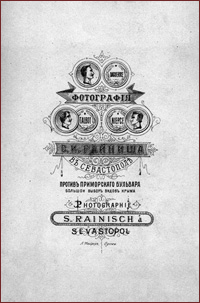|
GLASS PHOTOGRAPHIC PLATES – HOW THEY WERE PRODUCED
(A brief reminder of what is known)

One of the best photographers in the nineteenth century Sevastopol, S. I. Raynish glued thin paper photo prints to compact carton or passé-partout, the same as the other owners of photo studios did. These passé-partouts contained advertisement of the photo studio, were decorated with different vignettes and praised the studio owner. The image presented here possesses all the same images. Besides this, we can also see that Raynish’s passé-partout has three profiles of Daguerre, Niepce and Talbot, who were the fathers of photography. These “three holy warriors of photography” rightfully protected from above Mr Raynish’s shop.
- Joseph Nicephore Niepce (1765-1833 experimented with bitumen and oils, improved camera obscura and studied how to produce images that would not disappear. His meeting with famous designer from Paris Luis Daguerre (1787-1851)), who also was obsessed with the idea of getting realistic images, took place in 1827 (for us, this year is momentous because it marked the beginning of the archaeological excavations of Chersonesos). The friendship of two enthusiasts and their experiments with salts of silver resulted in the invention of daguerreotypy, that is a method of getting positive, specularly reflective image on a silver-coated metallic plate. Before making acquaintance with Daguerre, Niepce received imprints on stone, tin, lead, and even on paper, but it was after his death only that silver-coated plate, which was called daguerreotype, gained favour of his contemporaries. This technology, however, has important shortcomings of its high cost and impossibility of copying, so it was not possible to make more than one imprints of it. An Englishman Sir William Fox Talbot (1800-1877) who made experiments for producing stable images the same zealously as the Frenchmen did. He invented the process of getting stable imprint from negative image on paper covered with chloride of silver. He found it so beautiful that he called this technology calotypefrom Greek words “beautiful printing”. In comparison with heavy and made in one copy only daguerreotype it was really beautiful, calotype greatly advanced photography towards what is known to every of us. But it also has an important problem. This problem was inadequate sharpness of image because negative was based on paper, which transparency was obtained by waxing, which contributed to light dispersed in paper mass when printing images.
After the inventions of Niepce, Daguerre and Talbot in the field of photography, intensive searches started in order to fix the problems and overcome shortcomings. It was discovered that the best way of “light-writing” was by means of silver-salts using glass plates as emulsion carrier. However, it was necessary to have plain glass surface holding silver-containing solutions. It was 1851 when English sculptor and photography-lover Frederick Scott Archer invented the so-called wet collodion process: glass plate was covered with viscous collodion (nitrocellulose or pyroxylin) solution in the mixture of ether and alcohol. Although he received very sharp images that allowed making any number of prints on paper, an important problem of this technology was the necessity of making numerous operations with plate quickly before the covering hardened. Photographer had 10 to 15 minutes for everything. Besides that, ether vapour was unbearable to many people. A doctor from London Richard Leach Maddox used to suffocate in close room when doing his favourite photography, so he decided to make experiments with gelatine, that is a substance obtained by boiling in water the ligaments, bones, skin of animals. It was 1871 when the so-called dry bromide gelatine plates appeared: gelatine was dissolved in water, mixed with calcium bromide and then with silver nitrate. This emulsion was put on glass plate and dried. Shelf life of such plates reached few months from the production date. Accurate chemists would remind us that such solution has been called “emulsion” by mistake as it is in fact a real suspension, but chemists certainly can’t take the word emulsion out of use in such contexts in spoken language. This kind of plates was produced with use of hyposulphate. Soon bromide gelatine plates started to be produced industrially in great numbers, photo cameras and technologies of printing developed simultaneously, and photography became the occupation of more and more peoples.
The archive of the National Preserve of Tauric Chersonesos possessed glass photographic plates produced in different factories; it is known from documents that the museum purchased Sandel’s and Thomas’s plates with anti-halo layer, plates from Keller’s factory, as well as those produced by Pobeda factory owned by captain Zankovskiy. The most part of negatives are 13 x 18 cm. The quality of emulsion differs, which is not a surprise because standardization of photosensitivity and other parameters was achieved in a later period, each photographer made experiments with developing an image on plate and quality of imprints according to his own ideas. To sum up with the collection of photographic plates in the archive of Chersonesos, we should note that there already was a possibility of using photo film in that period, but it is likely that glass photographic plates with their high quality of image and possibility of reproducing the smallest details of photographed reality were the best background for taking pictures with scholarly purposes. This consideration has been proved now when making digital copies of the negatives: the quality of images is excellent, and you can appreciate it in our web page Gallery.
©O. Panasenko, 2008
|